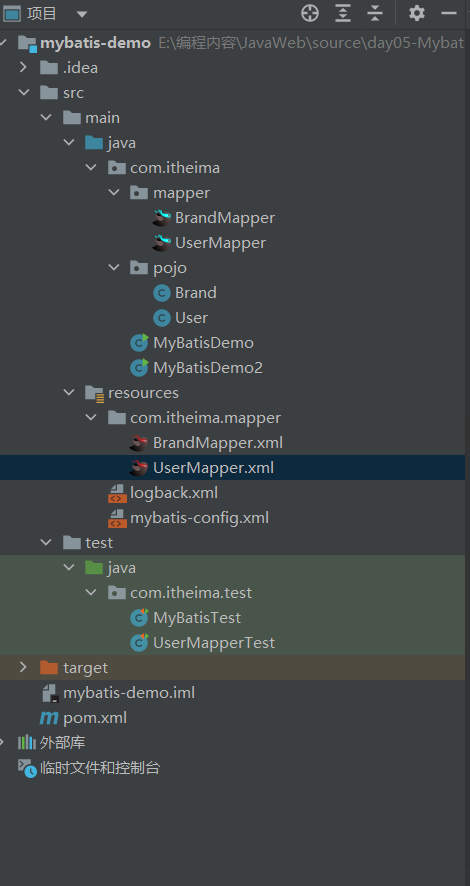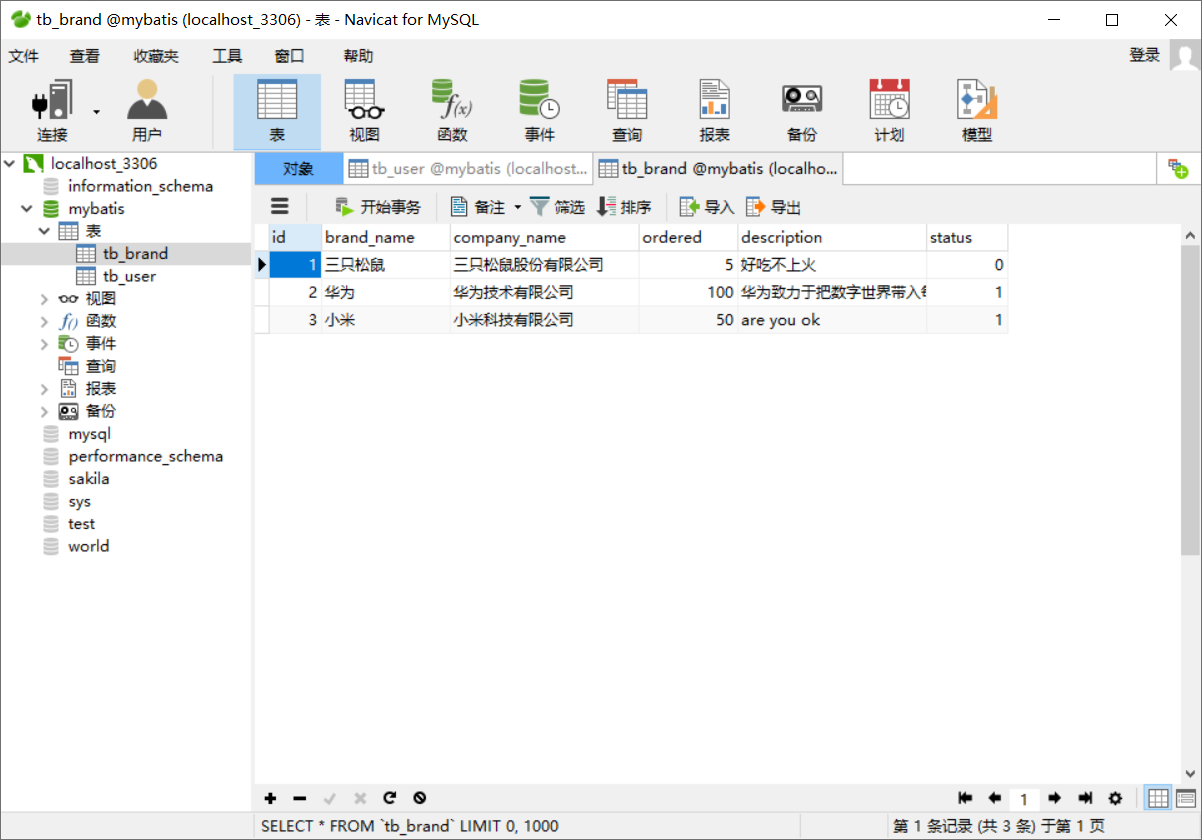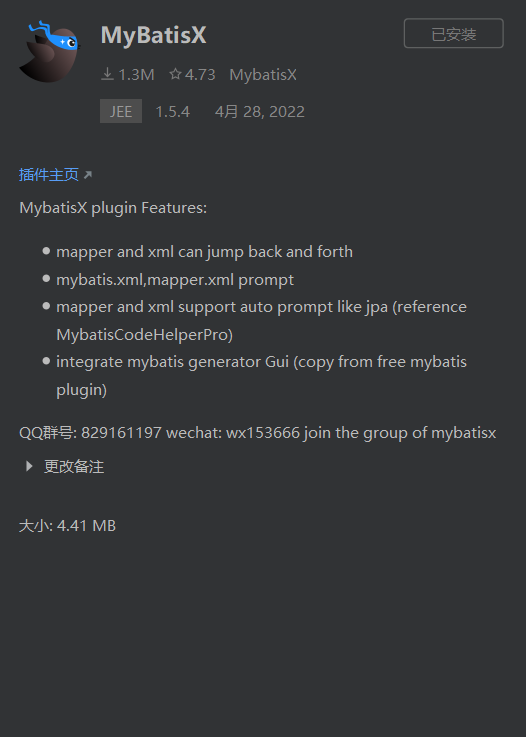? 优质资源分享 ?
| 学习路线指引(点击解锁) | 知识定位 | 人群定位 |
|---|---|---|
| ? Python实战微信订餐小程序 ? | 进阶级 | 本课程是python flask+微信小程序的完美结合,从项目搭建到腾讯云部署上线,打造一个全栈订餐系统。 |
| ?Python量化交易实战? | 入门级 | 手把手带你打造一个易扩展、更安全、效率更高的量化交易系统 |
一篇文章带你掌握主流数据库框架——MyBatis
MyBatis 是一款优秀的持久层框架,它支持自定义 SQL、存储过程以及高级映射。
在之前的文章中我们学习了MYSQL和JDBC,但是这些东西远远不足以支持我们书写JavaWeb相关的内容
在学习MyBatis前,请先学习Java,Mysql,JDBC,Maven内容
MyBatis学前须知
首先我们先简单介绍一下MyBatis:
- Mybats是一款优秀的持久层框架,用于简化JDBC开发
- MyBatis本是Apache的一个开源项目iBatis,2010年由apache software foundation 迁移到了google code,并改名为MyBatis
- 官网:MyBatis中文网
我们再来介绍一下JavaEE概念:
- JavaEE三层架构:表现层,业务层,持久层
- 表现层:负责接收客户端请求,向客户端响应结果
- 业务层:它负责业务逻辑处理
- 持久层:负责将数据保存到数据库的那一层代码
最后我们了解一下框架:
- 框架是一个半成品软件,是一套可重用的,通用的软件基础代码模型
- 在框架的基础上构建软件编写更加有效,规范,通用,可扩展
MyBatis产生背景
我们在前面提到MyBatis的产生是为了简化JDBC开发
那么我们就先来介绍一下JDBC的缺点:
我们通过一段代码进行解析:
package com.itheima.jdbc;
import org.junit.Test;
import java.sql.*;
import java.util.Date;
@Test
public void testPreparedStatement2() throws Exception {
// 前置链接操作
String url = "jdbc:mysql:///db1?useSSL=false&useServerPrepStmts=true";
String username = "root";
String password = "1234";
Connection conn = DriverManager.getConnection(url, username, password);
// 接收用户输入 用户名和密码
String name = "zhangsan";
String pwd = "' or '1' = '1";
// 定义sql
String sql = "select * from tb\_user where username = ? and password = ?";
// 获取pstmt对象
PreparedStatement pstmt = conn.prepareStatement(sql);
Thread.sleep(10000);
// 设置?的值
pstmt.setString(1,name);
pstmt.setString(2,pwd);
ResultSet rs = null;
// 执行sql
rs = pstmt.executeQuery();
// 设置?的值
pstmt.setString(1,"aaa");
pstmt.setString(2,"bbb");
// 执行sql
rs = pstmt.executeQuery();
// 判断登录是否成功
if(rs.next()){
System.out.println("登录成功~");
}else{
System.out.println("登录失败~");
}
//7. 释放资源
rs.close();
pstmt.close();
conn.close();
}
}
在上述代码中,我们可以注意到:
/*
硬编码概念: 代码展现形式固定,如果有所更改需要手动修改代码
硬编码动作:注册驱动,获得链接,SQL语句
*/
// 前置链接操作
String url = "jdbc:mysql:///db1?useSSL=false&useServerPrepStmts=true";
String username = "root";
String password = "1234";
Connection conn = DriverManager.getConnection(url, username, password);
// 接收用户输入 用户名和密码
String name = "zhangsan";
String pwd = "' or '1' = '1";
/*
操作繁琐:大量代码堆叠
操作繁琐动作:手动设置参数,手动封装结果
*/
// 获取pstmt对象
PreparedStatement pstmt = conn.prepareStatement(sql);
Thread.sleep(10000);
// 设置?的值
pstmt.setString(1,name);
pstmt.setString(2,pwd);
ResultSet rs = null;
// 执行sql
rs = pstmt.executeQuery();
// 设置?的值
pstmt.setString(1,"aaa");
pstmt.setString(2,"bbb");
// 执行sql
rs = pstmt.executeQuery();
因而为了解决JDBC的这些缺点,MyBatis应运而生!
MyBatis解决思想:
- 硬编码 -> 配置文件
- 注册驱动,获得连接:在mybatis-config.xml设置其连接池信息
- SQL语句:设置专门的Mapper接口和Mapper.xml设置其信息
- 操作繁琐 - > 自动完成
- 采用SqlSession对象的各类方法直接封装
MyBatis免除了几乎所有的JDBC代码以及设置参数和获得结果集的工作
MyBatis快速入门
我们将以一个案例进行MyBatis的快速入门(资源来自B站黑马程序员老陈的JavaWeb课程)
我们以步骤形式逐步进行:
- 准备数据库数据

- 创建模块,导入坐标(这里采用Maven创建项目,在项目自动生成的pom.xml中导入模块坐标即可)
<dependency>
<groupId>org.mybatisgroupId>
<artifactId>mybatisartifactId>
<version>3.5.5version>
dependency>
<dependency>
<groupId>mysqlgroupId>
<artifactId>mysql-connector-javaartifactId>
<version>5.1.46version>
dependency>
<dependency>
<groupId>junitgroupId>
<artifactId>junitartifactId>
<version>4.13version>
<scope>testscope>
dependency>
<dependency>
<groupId>org.slf4jgroupId>
<artifactId>slf4j-apiartifactId>
<version>1.7.20version>
dependency>
<dependency>
<groupId>ch.qos.logbackgroupId>
<artifactId>logback-classicartifactId>
<version>1.2.3version>
dependency>
<dependency>
<groupId>ch.qos.logbackgroupId>
<artifactId>logback-coreartifactId>
<version>1.2.3version>
dependency>
dependencies>
- 编写MyBatis核心配置文件(替换连接信息,解决硬编码问题)
xml version="1.0" encoding="UTF-8" ?
configuration
PUBLIC "-//mybatis.org//DTD Config 3.0//EN"
"http://mybatis.org/dtd/mybatis-3-config.dtd">
<configuration>
<environments default="development">
<environment id="development">
<transactionManager type="JDBC"/>
<dataSource type="POOLED">
<property name="driver" value="com.mysql.jdbc.Driver"/>
<property name="url" value="jdbc:mysql:///mybatis?useSSL=false"/>
<property name="username" value="root"/>
<property name="password" value="123456"/>
dataSource>
environment>
environments>
<mappers>
<mapper resource="com/itheima/mapper/UserMapper.xml"/>
mappers>
configuration>
- 创建SQL映射文件(统一管理sql语句,解决硬编码问题)
xml version="1.0" encoding="UTF-8" ?
mapper
PUBLIC "-//mybatis.org//DTD Mapper 3.0//EN"
"http://mybatis.org/dtd/mybatis-3-mapper.dtd">
<mapper namespace="test">
<select id="selectAll" resultType="User">
select * from Blog where id = #{id}
select>
mapper>
- 1 定义POJO类(与数据库信息完全相同的类)
// 注意:数据为private,书写get和set方法以及toString方法
package com.itheima.pojo;
// alt + 鼠标左键 整列编辑
public class User {
private Integer id;
private String username;
private String password;
private String gender;
private String addr;
public Integer getId() {
return id;
}
public void setId(Integer id) {
this.id = id;
}
public String getUsername() {
return username;
}
public void setUsername(String username) {
this.username = username;
}
public String getPassword() {
return password;
}
public void setPassword(String password) {
this.password = password;
}
public String getGender() {
return gender;
}
public void setGender(String gender) {
this.gender = gender;
}
public String getAddr() {
return addr;
}
public void setAddr(String addr) {
this.addr = addr;
}
@Override
public String toString() {
return "User{" +
"id=" + id +
", username='" + username + '\'' +
", password='" + password + '\'' +
", gender='" + gender + '\'' +
", addr='" + addr + '\'' +
'}';
}
}
- 2 主代码展示
// 创建主代码
package com.itheima;
import com.itheima.pojo.User;
import org.apache.ibatis.io.Resources;
import org.apache.ibatis.session.SqlSession;
import org.apache.ibatis.session.SqlSessionFactory;
import org.apache.ibatis.session.SqlSessionFactoryBuilder;
import java.io.IOException;
import java.io.InputStream;
import java.util.List;
/**
* Mybatis 快速入门代码
*/
public class MyBatisDemo {
public static void main(String[] args) throws IOException {
//1. 加载mybatis的核心配置文件,获取 SqlSessionFactory(官网下载)
/*
下述为官网下载,我们只需要修改第一行的mybatis-config.xml地址即可
String resource = "org/mybatis/example/mybatis-config.xml";
InputStream inputStream = Resources.getResourceAsStream(resource);
SqlSessionFactory sqlSessionFactory = new SqlSessionFactoryBuilder().build(inputStream);
*/
String resource = "mybatis-config.xml";
InputStream inputStream = Resources.getResourceAsStream(resource);
SqlSessionFactory sqlSessionFactory = new SqlSessionFactoryBuilder().build(inputStream);
//2. 获取SqlSession对象,用它来执行sql(sqlSessionFactory方法)
SqlSession sqlSession = sqlSessionFactory.openSession();
//3. 执行sql(这里的test.selectList是我们的UserMapper.xml中所设置的名称空间.id)
List users = sqlSession.selectList("test.selectAll");
System.out.println(users);
//4. 释放资源
sqlSession.close();
}
}
至此,我们已经了解了MyBatis的整体创建流程
在下面我们会以上述入门为标准,进行各种流程上的简化开发
解决SQL语句警告问题(IDEA正式版)
我们在Mapper.xml中书写sql语句时,可能会出现sql表名显示红色(报错)现象
产生原因:IDEA和数据库没有建立连接,不识别表信息
解决方法:在IDEA中配置MYSQL数据库连接
解决优点:代码不再报错,显示所有SQL语句以及表列的补全信息
解决方法:
- 在Database中打开加号,逐步打开Data Source,MYSQL
- 打开页面后,填写USer,Password即可
Mapper代理开发
我们在入门代码中创建了Mapper.xml,并在其中书写代码
我们在主项目的代码中包含有以下这段:
List users = sqlSession.selectList("test.selectAll");
但test.selectAll属于硬编码阶段,且书写方式麻烦
因而产生了Mapper代理开发,同样我们采用案例的形式逐步书写:
- 定义与SQL映射文件同名的Mapper接口,并将该接口与SQL映射文件放置在同一目录级别下(IDEA2022版已解决这个问题)

- 设置SQL映射文件的namespace属性为Mapper接口全限定名(接口与xml文件产生连接)
xml version="1.0" encoding="UTF-8" ?
mapper
PUBLIC "-//mybatis.org//DTD Mapper 3.0//EN"
"http://mybatis.org/dtd/mybatis-3-mapper.dtd">
<mapper namespace="com.itheima.mapper.UserMapper">
<select id="selectAll" resultType="user">
select *
from tb_user;
select>
mapper>
- 在Mapper接口中定义方法,方法名就是SQL映射文件中sql语句的id,并保持参数类型和返回值类型一致
package com.itheima.mapper;
import com.itheima.pojo.User;
import org.apache.ibatis.annotations.Param;
import org.apache.ibatis.annotations.Select;
import java.util.Collection;
import java.util.List;
import java.util.Map;
import java.util.Set;
public interface UserMapper {
List selectAll();
}
- 主代码展示:
package com.itheima;
import com.itheima.mapper.UserMapper;
import com.itheima.pojo.User;
import org.apache.ibatis.io.Resources;
import org.apache.ibatis.session.SqlSession;
import org.apache.ibatis.session.SqlSessionFactory;
import org.apache.ibatis.session.SqlSessionFactoryBuilder;
import java.io.IOException;
import java.io.InputStream;
import java.util.List;
/**
* Mybatis 代理开发
*/
public class MyBatisDemo2 {
public static void main(String[] args) throws IOException {
//1. 加载mybatis的核心配置文件,获取 SqlSessionFactory
String resource = "mybatis-config.xml";
InputStream inputStream = Resources.getResourceAsStream(resource);
SqlSessionFactory sqlSessionFactory = new SqlSessionFactoryBuilder().build(inputStream);
//2. 获取SqlSession对象,用它来执行sql
SqlSession sqlSession = sqlSessionFactory.openSession();
//3.1 获取UserMapper接口的代理对象
//(采用sqlSession方法获得接口类产生对象,调用对象的方法[这里方法来自xml],并根据Mapper接口设置的返回参数)
UserMapper userMapper = sqlSession.getMapper(UserMapper.class);
List users = userMapper.selectAll();
System.out.println(users);
//4. 释放资源
sqlSession.close();
}
}
Mapper补充内容
在mybatis-config.xml文件中我们设置过mapper内容:
<mappers>
<mapper resource="com/itheima/mapper/UserMapper.xml">
mappers>
但随着sql映射文件增多,单个书写过于麻烦,所以开发出了package方法
<package name="com.itheima.mapper"/>
MyBatis核心配置文件
Mybatis核心配置文件就是我们之前写入的mybatis-config.xml文件
现在我们对MyBatis的相关内容进行分析:
-
标签:
- 类型别名可为 Java 类型设置一个缩写名字。
- 它仅用于 XML 配置,意在降低冗余的全限定类名书写。
- 我们可以在标签内书写package标签,并设置文件夹名称,则后续内容中不需要添加该文件夹名称
-
标签:
- MyBatis 可以配置成适应多种环境,这种机制有助于将 SQL 映射应用于多种数据库之中
- 通过default设置信息来更换数据库,default的值为下述environment的id值
- Mapper,dataSource以及内部信息均已介绍,这里不再介绍
下面给出代码展示:
xml version="1.0" encoding="UTF-8" ?
configuration
PUBLIC "-//mybatis.org//DTD Config 3.0//EN"
"http://mybatis.org/dtd/mybatis-3-config.dtd">
<configuration>
<typeAliases>
<package name="com.itheima.pojo"/>
typeAliases>
<environments default="development">
<environment id="development">
<transactionManager type="JDBC"/>
<dataSource type="POOLED">
<property name="driver" value="com.mysql.jdbc.Driver"/>
<property name="url" value="jdbc:mysql:///mybatis?useSSL=false"/>
<property name="username" value="root"/>
<property name="password" value="123456"/>
dataSource>
environment>
<environment id="test">
<transactionManager type="JDBC"/>
<dataSource type="POOLED">
<property name="driver" value="com.mysql.jdbc.Driver"/>
<property name="url" value="jdbc:mysql:///mybatis?useSSL=false"/>
<property name="username" value="root"/>
<property name="password" value="1234"/>
dataSource>
environment>
environments>
<mappers>
<package name="com.itheima.mapper"/>
mappers>
configuration>
MyBatis进阶内容(增删改查)
在下述内容中,我们会通过一个案例进行MyBatis的增删改查并且补充相应知识点
在开始前,我们同样准备环境:
- 数据库表tb_brand

- 实体类Brand
package com.itheima.pojo;
/**
* 品牌
*
* alt + 鼠标左键:整列编辑
*
* 在实体类中,基本数据类型建议使用其对应的包装类型
*/
public class Brand {
// id 主键
private Integer id;
// 品牌名称
private String brandName;
// 企业名称
private String companyName;
// 排序字段
private Integer ordered;
// 描述信息
private String description;
// 状态:0:禁用 1:启用
private Integer status;
public Integer getId() {
return id;
}
public void setId(Integer id) {
this.id = id;
}
public String getBrandName() {
return brandName;
}
public void setBrandName(String brandName) {
this.brandName = brandName;
}
public String getCompanyName() {
return companyName;
}
public void setCompanyName(String companyName) {
this.companyName = companyName;
}
public Integer getOrdered() {
return ordered;
}
public void setOrdered(Integer ordered) {
this.ordered = ordered;
}
public String getDescription() {
return description;
}
public void setDescription(String description) {
this.description = description;
}
public Integer getStatus() {
return status;
}
public void setStatus(Integer status) {
this.status = status;
}
@Override
public String toString() {
return "Brand{" +
"id=" + id +
", brandName='" + brandName + '\'' +
", companyName='" + companyName + '\'' +
", ordered=" + ordered +
", description='" + description + '\'' +
", status=" + status +
'}';
}
}
- 测试用例(在test文件夹下的java文件下创建test即可)

- 安装MyBatisX插件(方便对应Mapper.xml和Mapper接口)

查询数据
我们将会介绍三种数据查询方法:
- 查询所有数据
- 根据ID查询单个数据
- 根据条件查询数据
接下来我们逐一讲解:
查询所有数据
查询所有数据步骤:
- 编写接口方法:Mapper接口(参数:无 返回类型:List)
package com.itheima.mapper;
import com.itheima.pojo.Brand;
import org.apache.ibatis.annotations.Param;
import org.apache.ibatis.annotations.ResultMap;
import org.apache.ibatis.annotations.Select;
import java.util.List;
import java.util.Map;
public interface BrandMapper {
/**
* 查询所有
*/
List selectAll();
}
- 编写SQL语句(在xml中编写)
<select id="selectAll" resultType="brand">
select *
from tb_brand;
select>
- 执行方式
@Test
public void testSelectAll() throws IOException {
//1. 获取SqlSessionFactory
String resource = "mybatis-config.xml";
InputStream inputStream = Resources.getResourceAsStream(resource);
SqlSessionFactory sqlSessionFactory = new SqlSessionFactoryBuilder().build(inputStream);
//2. 获取SqlSession对象
SqlSession sqlSession = sqlSessionFactory.openSession();
//3. 获取Mapper接口的代理对象
BrandMapper brandMapper = sqlSession.getMapper(BrandMapper.class);
//4. 执行方法
List brands = brandMapper.selectAll();
System.out.println(brands);
//5. 释放资源
sqlSession.close();
}
但是这种方法中,我们会发现brandName和companyName并没有显示
主要原因:
- brandName在MYSQL中定义为brand_name;companyName在MYSQL中定义为company_name
解决方法有两种:
- 给所有名称不同的属性添加别名,使其与MYSQL属性同名
<mapper namespace="com.itheima.mapper.BrandMapper">
<select id="selectAll" resultMap="brandResultMap">
select id, brand_name as brandName, company_name as companyName, ordered, description, status
from tb_brand;
select>
mapper>
- 在xml中添加一段ResultMap属性(推荐!!!)
<mapper namespace="com.itheima.mapper.BrandMapper">
<resultMap id="brandResultMap" type="brand">
<result column="brand\_name" property="brandName"/>
<result column="company\_name" property="companyName"/>
resultMap>
<select id="selectAll" resultMap="brandResultMap">
select *
from tb_brand;
select>
<select id="selectAll" resultMap="brand">
select *
from tb_brand;
select>
mapper>
单个查询
单个查询步骤:
- 编写接口方法:Mapper接口(参数:id 返回类型:Brand)
Brand selectById(int id);
- 编写SQL语句
<select id="selectById" resultMap="brandResultMap">
select *
from tb_brand
where id = #{id};
select>
- 执行方法,测试
@Test
public void testSelectById() throws IOException {
//接收参数
int id = 1;
//1. 获取SqlSessionFactory
String resource = "mybatis-config.xml";
InputStream inputStream = Resources.getResourceAsStream(resource);
SqlSessionFactory sqlSessionFactory = new SqlSessionFactoryBuilder().build(inputStream);
//2. 获取SqlSession对象
SqlSession sqlSession = sqlSessionFactory.openSession();
//3. 获取Mapper接口的代理对象
BrandMapper brandMapper = sqlSession.getMapper(BrandMapper.class);
//4. 执行方法
Brand brand = brandMapper.selectById(id);
System.out.println(brand);
//5. 释放资源
sqlSession.close();
}
知识点讲解:
-
{}:会将其替换为 ? 放置SQL注入
- ${}:拼接sql,会存在SQL注入问题
- 使用时机:
- 参数传递:#{}
- 表名或列名不固定的情况下:${}
条件查询
这里我们介绍多条件查询:
- 编写接口方法:Mapper接口(参数:所有查询条件 返回结果:List)
/**
* 条件查询
* * 参数接收
* 1. 散装参数:如果方法中有多个参数,需要使用@Param("SQL参数占位符名称")
* 2. 对象参数:对象的属性名称要和参数占位符名称一致
* 3. map集合参数
*
*/
List selectByCondition(@Param("status") int status, @Param("companyName") String companyName, @Param("brandName") String brandName);
List selectByCondition(Brand brand);
List selectByCondition(Map map);
- 编写SQL语句:
<select id="selectByCondition" resultMap="brandResultMap">
select *
from tb_brand
where status = #{status}
and company_name like #{companyName}
and brand_name like #{brandName}
select>
- 执行方法,测试:
@Test
public void testSelectByCondition() throws IOException {
//接收参数
int status = 1;
String companyName = "华为";
String brandName = "华为";
// 处理参数
companyName = "%" + companyName + "%";
brandName = "%" + brandName + "%";
//封装对象
/* Brand brand = new Brand();
brand.setStatus(status);
brand.setCompanyName(companyName);
brand.setBrandName(brandName);*/
Map map = new HashMap();
// map.put("status" , status);
map.put("companyName", companyName);
// map.put("brandName" , brandName);
//1. 获取SqlSessionFactory
String resource = "mybatis-config.xml";
InputStream inputStream = Resources.getResourceAsStream(resource);
SqlSessionFactory sqlSessionFactory = new SqlSessionFactoryBuilder().build(inputStream);
//2. 获取SqlSession对象
SqlSession sqlSession = sqlSessionFactory.openSession();
//3. 获取Mapper接口的代理对象
BrandMapper brandMapper = sqlSession.getMapper(BrandMapper.class);
//4. 执行方法
//List brands = brandMapper.selectByCondition(status, companyName, brandName);
// List brands = brandMapper.selectByCondition(brand);
List brands = brandMapper.selectByCondition(map);
System.out.println(brands);
//5. 释放资源
sqlSession.close();
}
动态查询
动态查询概念:
- 在所有的查询条件中,用户可能并不会全部查询,可能只有挑选条件查询
- 这时如果以之前的代码,会导致导入值为null而导致查询错误
动态SQL语句:
- if语句
<select id="findActiveBlogWithTitleLike"
resultType="Blog">
SELECT * FROM BLOG
WHERE state = ‘ACTIVE’
<if test="title != null">
AND title like #{title}
if>
select>
- where语句
<select id="selectByCondition" resultMap="brandResultMap">
select *
from tb_brand
/* where 1 = 1*/
<where>
<if test="status != null">
and status = #{status}
if>
<if test="companyName != null and companyName != '' ">
and company_name like #{companyName}
if>
<if test="brandName != null and brandName != '' ">
and brand_name like #{brandName}
if>
where>
- choose语句
<when test="status != null">
-->
<select id="findActiveBlogLike"
resultType="Blog">
SELECT * FROM BLOG WHERE state = ‘ACTIVE’
<choose>
<when test="title != null">
AND title like #{title}
when>
<when test="author != null and author.name != null">
AND author_name like #{author.name}
when>
<otherwise>
AND featured = 1
otherwise>
choose>
select>
我们根据两个案例来解释上述语法:
- 多条件查询语句:
- 编写接口方法:Mapper接口(参数:Brand 返回类型:List)
List selectByCondition(Brand brand);
- 编写SQL语句:
<select id="selectByCondition" resultMap="brandResultMap">
select *
from tb_brand
/* where 1 = 1*/
<where>
<if test="status != null">
and status = #{status}
if>
<if test="companyName != null and companyName != '' ">
and company_name like #{companyName}
if>
<if test="brandName != null and brandName != '' ">
and brand_name like #{brandName}
if>
where>
select>
- 执行方法,测试:
@Test
public void testSelectByCondition() throws IOException {
//接收参数
int status = 1;
String companyName = "华为";
String brandName = "华为";
// 处理参数
companyName = "%" + companyName + "%";
brandName = "%" + brandName + "%";
//封装对象
Brand brand = new Brand();
brand.setStatus(status);
brand.setCompanyName(companyName);
brand.setBrandName(brandName);
//1. 获取SqlSessionFactory
String resource = "mybatis-config.xml";
InputStream inputStream = Resources.getResourceAsStream(resource);
SqlSessionFactory sqlSessionFactory = new SqlSessionFactoryBuilder().build(inputStream);
//2. 获取SqlSession对象
SqlSession sqlSession = sqlSessionFactory.openSession();
//3. 获取Mapper接口的代理对象
BrandMapper brandMapper = sqlSession.getMapper(BrandMapper.class);
//4. 执行方法
List brands = brandMapper.selectByCondition(brand);
System.out.println(brands);
//5. 释放资源
sqlSession.close();
}
- 单条件动态查询:
- 编写接口方法:Mapper接口(参数:Brand 返回类型:List)
List selectByConditionSingle(Brand brand);
- 编写SQL语句:
<select id="selectByConditionSingle" resultMap="brandResultMap">
select *
from tb_brand
<where>
<choose>
<when test="status != null">
status = #{status}
when>
<when test="companyName != null and companyName != '' ">
company_name like #{companyName}
when>
<when test="brandName != null and brandName != ''">
brand_name like #{brandName}
when>
choose>
where>
select>
- 执行方法,测试:
@Test
public void testSelectByConditionSingle() throws IOException {
//接收参数
int status = 1;
String companyName = "华为";
String brandName = "华为";
// 处理参数
companyName = "%" + companyName + "%";
brandName = "%" + brandName + "%";
//封装对象
Brand brand = new Brand();
//brand.setStatus(status);
brand.setCompanyName(companyName);
//brand.setBrandName(brandName);
//1. 获取SqlSessionFactory
String resource = "mybatis-config.xml";
InputStream inputStream = Resources.getResourceAsStream(resource);
SqlSessionFactory sqlSessionFactory = new SqlSessionFactoryBuilder().build(inputStream);
//2. 获取SqlSession对象
SqlSession sqlSession = sqlSessionFactory.openSession();
//3. 获取Mapper接口的代理对象
BrandMapper brandMapper = sqlSession.getMapper(BrandMapper.class);
//4. 执行方法
List brands = brandMapper.selectByConditionSingle(brand);
System.out.println(brands);
//5. 释放资源
sqlSession.close();
}
添加数据
在这小节我们会讲到添加功能并附带返回主键:
添加功能
添加功能步骤:
- 编写接口方法:Mapper接口(参数:Brand 返回类型:void )
void add(Brand brand);
- 编写MYSQL语句:
<insert id="add" useGeneratedKeys="true" keyProperty="id">
insert into tb_brand (brand_name, company_name, ordered, description, status)
values (#{brandName}, #{companyName}, #{ordered}, #{description}, #{status});
insert>
- 代码调试,测试:
@Test
public void testAdd() throws IOException {
//接收参数
int status = 1;
String companyName = "波导手机";
String brandName = "波导";
String description = "手机中的战斗机";
int ordered = 100;
//封装对象
Brand brand = new Brand();
brand.setStatus(status);
brand.setCompanyName(companyName);
brand.setBrandName(brandName);
brand.setDescription(description);
brand.setOrdered(ordered);
//1. 获取SqlSessionFactory
String resource = "mybatis-config.xml";
InputStream inputStream = Resources.getResourceAsStream(resource);
SqlSessionFactory sqlSessionFactory = new SqlSessionFactoryBuilder().build(inputStream);
//2. 获取SqlSession对象
SqlSession sqlSession = sqlSessionFactory.openSession();
// 这里openSession的参数未设置时为手动提交信息,设置true后为自动提交事务
//SqlSession sqlSession = sqlSessionFactory.openSession(true);
//3. 获取Mapper接口的代理对象
BrandMapper brandMapper = sqlSession.getMapper(BrandMapper.class);
//4. 执行方法(这里就可以对brand的id进行提取,并输出)
brandMapper.add(brand);
Integer id = brand.getId();
System.out.println(id);
// 执行add后并未立刻执行,我们需要提交事务才能反馈到数据库中
sqlSession.commit();
//5. 释放资源
sqlSession.close();
}
修改数据
该小节中我们会介绍两种修改方法:
- 全字段修改
- 单字段修改
我们会在下述内容中一一讲解:
全字段修改
- 编写接口方法:Mapper接口(参数:所有数据 返回类型:int(修改行)或void)
int update(Brand brand);
- 编写MYSQL语句:
<update id="update">
update tb_brand
set brand_name = #{brandName},
company_name = #{companyName},
ordered = #{ordered},
description = #{description},
status = #{status}
where id = #{id};
update>
- 执行方法,测试:
@Test
public void testUpdate() throws IOException {
//接收参数
int status = 0;
String companyName = "波导手机";
String brandName = "波导";
String description = "波导手机,手机中的战斗机";
int ordered = 200;
int id = 6;
//封装对象
Brand brand = new Brand();
brand.setStatus(status);
brand.setCompanyName(companyName);
brand.setBrandName(brandName);
brand.setDescription(description);
brand.setOrdered(ordered);
brand.setId(id);
//1. 获取SqlSessionFactory
String resource = "mybatis-config.xml";
InputStream inputStream = Resources.getResourceAsStream(resource);
SqlSessionFactory sqlSessionFactory = new SqlSessionFactoryBuilder().build(inputStream);
//2. 获取SqlSession对象
SqlSession sqlSession = sqlSessionFactory.openSession();
//SqlSession sqlSession = sqlSessionFactory.openSession(true);
//3. 获取Mapper接口的代理对象
BrandMapper brandMapper = sqlSession.getMapper(BrandMapper.class);
//4. 执行方法
int count = brandMapper.update(brand);
System.out.println(count);
//提交事务
sqlSession.commit();
//5. 释放资源
sqlSession.close();
}
单字段修改
- 编写接口方法:Mapper接口(参数:所有数据 返回类型:int(修改行)或void)
int update(Brand brand);
- 编写MYSQL语句:
<update id="update">
update tb_brand
<set>
<if test="brandName != null and brandName != ''">
brand_name = #{brandName},
if>
<if test="companyName != null and companyName != ''">
company_name = #{companyName},
if>
<if test="ordered != null">
ordered = #{ordered},
if>
<if test="description != null and description != ''">
description = #{description},
if>
<if test="status != null">
status = #{status}
if>
set>
where id = #{id};
update>
- 执行方法,测试:
@Test
public void testUpdate() throws IOException {
//接收参数
int status = 0;
String companyName = "波导手机";
String brandName = "波导";
String description = "波导手机,手机中的战斗机";
int ordered = 200;
int id = 6;
//封装对象
Brand brand = new Brand();
brand.setStatus(status);
// brand.setCompanyName(companyName);
// brand.setBrandName(brandName);
// brand.setDescription(description);
// brand.setOrdered(ordered);
brand.setId(id);
//1. 获取SqlSessionFactory
String resource = "mybatis-config.xml";
InputStream inputStream = Resources.getResourceAsStream(resource);
SqlSessionFactory sqlSessionFactory = new SqlSessionFactoryBuilder().build(inputStream);
//2. 获取SqlSession对象
SqlSession sqlSession = sqlSessionFactory.openSession();
//SqlSession sqlSession = sqlSessionFactory.openSession(true);
//3. 获取Mapper接口的代理对象
BrandMapper brandMapper = sqlSession.getMapper(BrandMapper.class);
//4. 执行方法
int count = brandMapper.update(brand);
System.out.println(count);
//提交事务
sqlSession.commit();
//5. 释放资源
sqlSession.close();
}
删除功能
这节介绍删除功能的两种形式:
- 单个删除
- 多个删除
我们将会在下面一一讲解:
单个删除
- 编写接口方法:Mapper接口(参数:id 返回类型:void)
void deleteById(int id);
- 编写MYSQL:
<delete id="deleteById">
delete from tb_brand where id = #{id};
delete>
- 代码执行,测试:
@Test
public void testDeleteById() throws IOException {
//接收参数
int id = 6;
//1. 获取SqlSessionFactory
String resource = "mybatis-config.xml";
InputStream inputStream = Resources.getResourceAsStream(resource);
SqlSessionFactory sqlSessionFactory = new SqlSessionFactoryBuilder().build(inputStream);
//2. 获取SqlSession对象
SqlSession sqlSession = sqlSessionFactory.openSession();
//SqlSession sqlSession = sqlSessionFactory.openSession(true);
//3. 获取Mapper接口的代理对象
BrandMapper brandMapper = sqlSession.getMapper(BrandMapper.class);
//4. 执行方法
brandMapper.deleteById(id);
//提交事务
sqlSession.commit();
//5. 释放资源
sqlSession.close();
}
多个删除
- 编写接口方法:Mapper接口(参数:int[] id 返回类型:void)
void deleteByIds(int[] ids);
- 编写MYSQL代码:
<delete id="deleteByIds">
delete from tb_brand where id
in
<foreach collection="array" item="id" separator="," open="(" close=")">
#{id}
foreach>
;
delete>
- 代码运行,测试:
@Test
public void testDeleteByIds() throws IOException {
//接收参数
int[] ids = {5,7,8};
//1. 获取SqlSessionFactory
String resource = "mybatis-config.xml";
InputStream inputStream = Resources.getResourceAsStream(resource);
SqlSessionFactory sqlSessionFactory = new SqlSessionFactoryBuilder().build(inputStream);
//2. 获取SqlSession对象
SqlSession sqlSession = sqlSessionFactory.openSession();
//SqlSession sqlSession = sqlSessionFactory.openSession(true);
//3. 获取Mapper接口的代理对象
BrandMapper brandMapper = sqlSession.getMapper(BrandMapper.class);
//4. 执行方法
brandMapper.deleteByIds(ids);
//提交事务
sqlSession.commit();
//5. 释放资源
sqlSession.close();
}
参数传递
MyBatis接口方法中可以接收各种各样的参数,MyBatis底层对这些参数有着不同的封装处理方法
我们在下面一一介绍:
多参数传递
在接口多参数传递中会把所有参数转移为Map集合
会转化为两种Map集合:
- arg集合,下标从0开始: arg[0]
- Param集合,下标从1开始: Param[1]
我们在xml中也可以直接使用arg或param来直接表示(但不推荐,因为不能直观得到信息)
我们所推荐的做法是使用@Param注解:
- 在参数前加上注解@Param("")
- 注意:这里使用Param注解实际上是对Param集合的键进行修改,也就是说你的Param集合将不再能够使用
单参数传递
常见的单参数传递分为六种:
- POJO类型: 直接使用, 属性名 和 参数占位符 名称一致即可
- Map集合: 直接使用,键名 和 参数占位符 名称一致即可
-
Collection: 封装为Map集合
- map.put("arg0",collection集合);
- map.put("collection",collection集合);
-
List: 封装为Map集合
- map.put("arg0",List集合);
- map.put("collection",List集合);
- map.put("list",List集合);
-
Array:封装为Map
- map.put("arg0",数组);
- map.put("array",数组);
- 其他类型:直接使用
注解开发
我们先来介绍注解开发的格式:
- 注解开发写在Mapper接口的方法中
// 相当于节省了xml的一步,直接在接口中定义方法
@Select("select * from tb\_user where id = #{id}")
List selectAll();
当然,注解的方法也分为四种:
- @Select
- @Insert
- @Update
- @Delete
注解的优缺点:
- 优点 : 注解完成简单功能,方便快捷
- 缺点 : 注解会导致Java代码繁琐,在接口中书写大量Java和MYSQL代码导致可读性变差
使用注解来映射简单语句会使代码显得更加简洁,但对于稍微复杂一点的语句,Java 注解不仅力不从心,还会让你本就复杂的 SQL 语句更加混乱不堪。 因此,如果你需要做一些很复杂的操作,最好用 XML 来映射语句。
选择何种方式来配置映射,以及认为是否应该要统一映射语句定义的形式,完全取决于你和你的团队。 换句话说,永远不要拘泥于一种方式,你可以很轻松的在基于注解和 XML 的语句映射方式间自由移植和切换。
结束语
好的,关于MyBatis的内容就介绍到这里,希望能为你带来帮助!
附录
该文章属于学习内容,具体参考B站黑马程序员陈老师的JavaWeb课程
这里附上链接:01-MyBatis简介_哔哩哔哩_bilibili
转载请注明:xuhss » 一篇文章带你掌握主流数据库框架——MyBatis